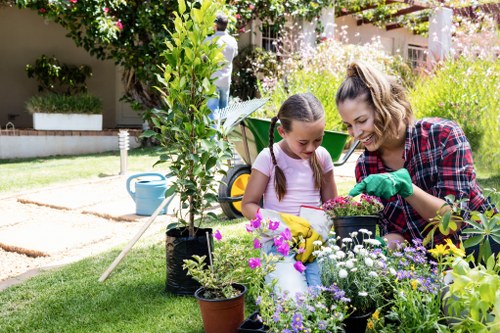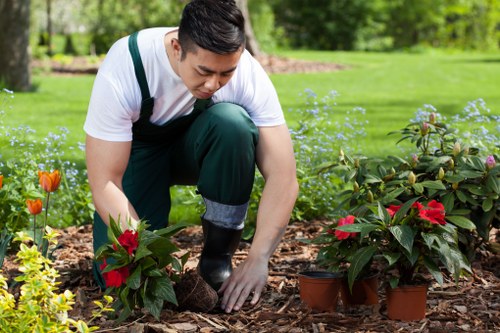Landscape Gardeners Woodlands

Introduction to Landscape Gardening in Woodlands
Welcome to the world of landscape gardeners in Woodlands, where nature meets artistry. Whether you're looking to transform your backyard or maintain a large woodland area, professional landscape gardeners bring both creativity and expertise to your outdoor spaces.
Woodlands offer a unique environment for gardening, with diverse flora and fauna that require specialized care. Understanding the intricacies of woodland gardening can enhance the beauty and sustainability of your landscape.
In this article, we'll explore the key aspects of landscape gardening in Woodlands, the benefits it offers, and how to choose the right professional to bring your vision to life.

Why Choose Professional Landscape Gardeners?
Hiring professional landscape gardeners in Woodlands ensures that your garden is not only aesthetically pleasing but also environmentally sustainable. These experts have the knowledge and tools to manage the unique challenges posed by woodland environments.
From soil health to plant selection, professional gardeners understand how to create a harmonious balance between the natural elements and your garden design. They can help you select native plants that thrive in woodland settings, reducing maintenance efforts and fostering biodiversity.
Moreover, professional landscape gardeners can provide tailored solutions that align with your specific needs and preferences, ensuring that your garden reflects your personal style while respecting the natural ecosystem.

Key Elements of Woodland Landscape Gardening
Designing a garden in Woodlands involves several key elements that contribute to its overall success. Here are some essential components:
- Plant Selection: Choosing the right plants is crucial. Opt for native species that are well-adapted to the local climate and soil conditions.
- Soil Management: Healthy soil is the foundation of a thriving garden. Professional gardeners assess and improve soil quality through composting and other techniques.
- Water Management: Efficient irrigation systems ensure that plants receive adequate moisture without wastage.
- Pathways and Structures: Incorporating pathways, pergolas, and other structures adds functionality and aesthetic appeal.
- Wildlife Support: Creating habitats for local wildlife enhances the biodiversity and ecological value of your garden.

Plant Selection for Woodlands
Choosing the right plants for a woodland environment is vital. Native plants are typically more resilient and require less maintenance. They also support local wildlife, including pollinators and birds.
Consider incorporating a mix of shrubs, trees, and groundcovers to create layers of vegetation. This not only adds depth to your garden but also provides various habitats for different species.
Some popular native plants for Woodlands include:
- Ferns: Thrive in shaded areas and add lush greenery.
- Hostas: Known for their attractive foliage and shade tolerance.
- Dogwoods: Offer beautiful blossoms and fruit that attract birds.
- Bluebells: Provide stunning spring color and support pollinators.

Soil Health and Management
Healthy soil is essential for the growth and sustainability of your woodland garden. Professional landscape gardeners assess soil quality and implement strategies to enhance it.
Key practices include:
- Composting: Adding organic matter improves soil structure and fertility.
- Mulching: Retains moisture, suppresses weeds, and regulates soil temperature.
- pH Adjustment: Ensuring the soil pH is suitable for the selected plants.
- Erosion Control: Implementing measures to prevent soil erosion, especially on slopes.

Benefits of Landscape Gardening in Woodlands
Engaging in landscape gardening within Woodlands offers numerous benefits. It not only enhances the beauty of your outdoor space but also contributes to environmental sustainability.
Some key benefits include:
- Enhanced Aesthetics: A well-designed garden adds visual appeal and can increase property value.
- Environmental Conservation: Promotes biodiversity and supports local ecosystems.
- Health Benefits: Gardening is a great way to reduce stress and improve mental well-being.
- Sustainability: Uses eco-friendly practices that conserve resources and minimize waste.
Moreover, a thoughtfully designed woodland garden can serve as a sanctuary for both humans and wildlife, fostering a deeper connection with nature.

Environmental Impact
Landscape gardening in Woodlands plays a significant role in environmental conservation. By selecting native plants and implementing sustainable practices, gardeners help maintain the ecological balance.
Key environmental impacts include:
- Carbon Sequestration: Trees and plants absorb carbon dioxide, helping to mitigate climate change.
- Water Conservation: Efficient irrigation and soil management reduce water usage.
- Habitat Creation: Provides shelter and food for various wildlife species.
- Soil Preservation: Prevents erosion and maintains soil fertility.
These practices not only benefit the environment but also ensure that your garden remains healthy and vibrant for years to come.

Choosing the Right Landscape Gardener
Selecting a qualified landscape gardener in Woodlands is crucial for the success of your garden project. Here are some tips to help you make the right choice:
- Experience: Look for gardeners with extensive experience in woodland environments.
- Portfolio: Review their previous projects to assess their style and expertise.
- References: Ask for testimonials or speak with past clients.
- Certifications: Ensure they have relevant qualifications and licenses.
- Communication: Choose someone who listens to your ideas and provides clear guidance.
By taking the time to find the right professional, you can ensure that your woodland garden is in capable hands.

Cost Factors
The cost of landscape gardening in Woodlands can vary based on several factors. Understanding these can help you plan your budget effectively.
- Size of the Area: Larger gardens require more materials and labor.
- Plant Selection: Rare or mature plants may be more expensive.
- Design Complexity: Intricate designs with multiple features will cost more.
- Soil and Irrigation: Soil amendments and irrigation systems add to the overall cost.
- Maintenance: Ongoing maintenance services can be an additional expense.
It's advisable to obtain detailed quotes and discuss your budget with your landscape gardener to ensure transparency and avoid unexpected costs.

Local Areas Near Woodlands for Landscape Gardening
Woodlands is surrounded by several areas that are ideal for landscape gardening. Each area offers unique features that can complement your garden design.
- Town A: Located just 5 miles from Woodlands, known for its lush parks and community gardens.
- Village B: A 7-mile radius area with diverse plant nurseries and landscaping suppliers.
- Suburb C: 10 miles away, famous for its sustainable gardening practices and eco-friendly gardens.
- City D: 12 miles from Woodlands, offers a range of professional landscape services and design studios.
- Hamlet E: Situated 8 miles nearby, home to several award-winning gardens and botanical gardens.
- Region F: 15 miles away, known for its extensive woodland trails and nature reserves.
- Area G: 6 miles from Woodlands, features numerous garden centers and plant boutiques.
- Neighborhood H: 9 miles distant, renowned for its community-driven gardening projects and workshops.
- Locale I: 11 miles out, offers specialized services in woodland landscape restoration.
- District J: 14 miles from Woodlands, characterized by its modern garden designs and innovative landscaping techniques.

Maintaining Your Woodland Garden
Once your woodland garden is established, regular maintenance is essential to keep it thriving. Here are some maintenance tips:
- Pruning: Regularly trim plants to encourage healthy growth and prevent overcrowding.
- Weeding: Keep weeds under control to reduce competition for nutrients and water.
- Watering: Ensure consistent watering, especially during dry spells.
- Fertilizing: Apply appropriate fertilizers to replenish soil nutrients.
- Pest Control: Monitor for pests and treat them using eco-friendly methods.
Engaging with your landscape gardener for periodic maintenance can help sustain the beauty and health of your woodland garden.

Seasonal Considerations
Each season brings its own set of challenges and opportunities for woodland gardening. Understanding seasonal changes can help you plan effectively:
- Spring: Focus on planting new species and preparing the soil.
- Summer: Manage watering needs and protect plants from excessive heat.
- Autumn: Conduct pruning and prepare plants for the winter months.
- Winter: Protect sensitive plants and plan for the upcoming gardening season.
Seasonal planning ensures that your garden remains vibrant and resilient throughout the year.

Eco-Friendly Landscaping Practices
Adopting eco-friendly practices in your woodland garden not only benefits the environment but also enhances the sustainability of your garden. Here are some green practices to consider:
- Rainwater Harvesting: Collecting rainwater reduces reliance on municipal water supplies.
- Composting: Recycling organic waste enriches the soil naturally.
- Native Planting: Supports local biodiversity and reduces maintenance needs.
- Organic Pest Control: Uses natural methods to manage pests without harmful chemicals.
- Sustainable Materials: Utilize recycled or renewable materials for garden structures.
Implementing these practices creates a harmonious and environmentally responsible garden.

Incorporating Water Features
Water features like ponds, fountains, and streams can add tranquility and beauty to your woodland garden. They also attract wildlife such as birds and butterflies.
When incorporating water features:
- Placement: Ensure the feature complements the natural landscape.
- Maintenance: Regularly clean and manage the water quality.
- Safety: Implement measures to prevent accidents, especially if children are present.
Water features create focal points and enhance the sensory experience of your garden.

Lighting for Woodland Gardens
Proper lighting can transform your woodland garden, making it enchanting during the evening hours. It also enhances safety and highlights key features.
- Pathway Lighting: Guides visitors and prevents trips.
- Accent Lighting: Highlights sculptures, trees, or architectural elements.
- Solar Lights: Eco-friendly option that reduces energy consumption.
- String Lights: Adds a magical ambiance to seating areas and patios.
Strategically placed lighting creates a captivating atmosphere while showcasing the beauty of your woodland garden.

Conclusion
Landscape gardening in Woodlands is a rewarding endeavor that combines creativity with ecological responsibility. By partnering with skilled landscape gardeners, you can create a stunning and sustainable outdoor space that thrives throughout the year.
From thoughtful plant selection to eco-friendly practices, every aspect of woodland gardening contributes to the overall success and beauty of your garden. Embrace the journey of transforming your woodland area into a vibrant sanctuary that reflects your personal style and supports the local ecosystem.
Start your landscape gardening project today and experience the myriad benefits of a well-designed woodland garden.

Frequently Asked Questions
1. What types of plants are best suited for woodland gardens?
Native plants such as ferns, hostas, dogwoods, and bluebells are ideal for woodland gardens. They are well-adapted to the local climate and soil conditions, requiring less maintenance and supporting local wildlife.
2. How often should I water my woodland garden?
Watering needs depend on the specific plants and local climate. Generally, woodland gardens require consistent moisture, especially during dry periods. It's best to consult with a professional landscape gardener to create an effective irrigation plan.
3. Can I incorporate a pond in my woodland garden?
Yes, water features like ponds can enhance the beauty and tranquility of your woodland garden. They attract wildlife and create focal points. Ensure proper placement and maintenance to integrate them seamlessly into your garden design.
4. How do I maintain soil health in my woodland garden?
Maintain soil health by adding organic matter through composting, using mulch to retain moisture, and periodically testing soil pH levels. Regularly aerate the soil and practice sustainable gardening techniques to keep it fertile and well-structured.
5. What are some eco-friendly landscaping practices?
Eco-friendly practices include rainwater harvesting, composting, using native plants, organic pest control, and choosing sustainable materials for garden structures. These methods help conserve resources and promote environmental sustainability.